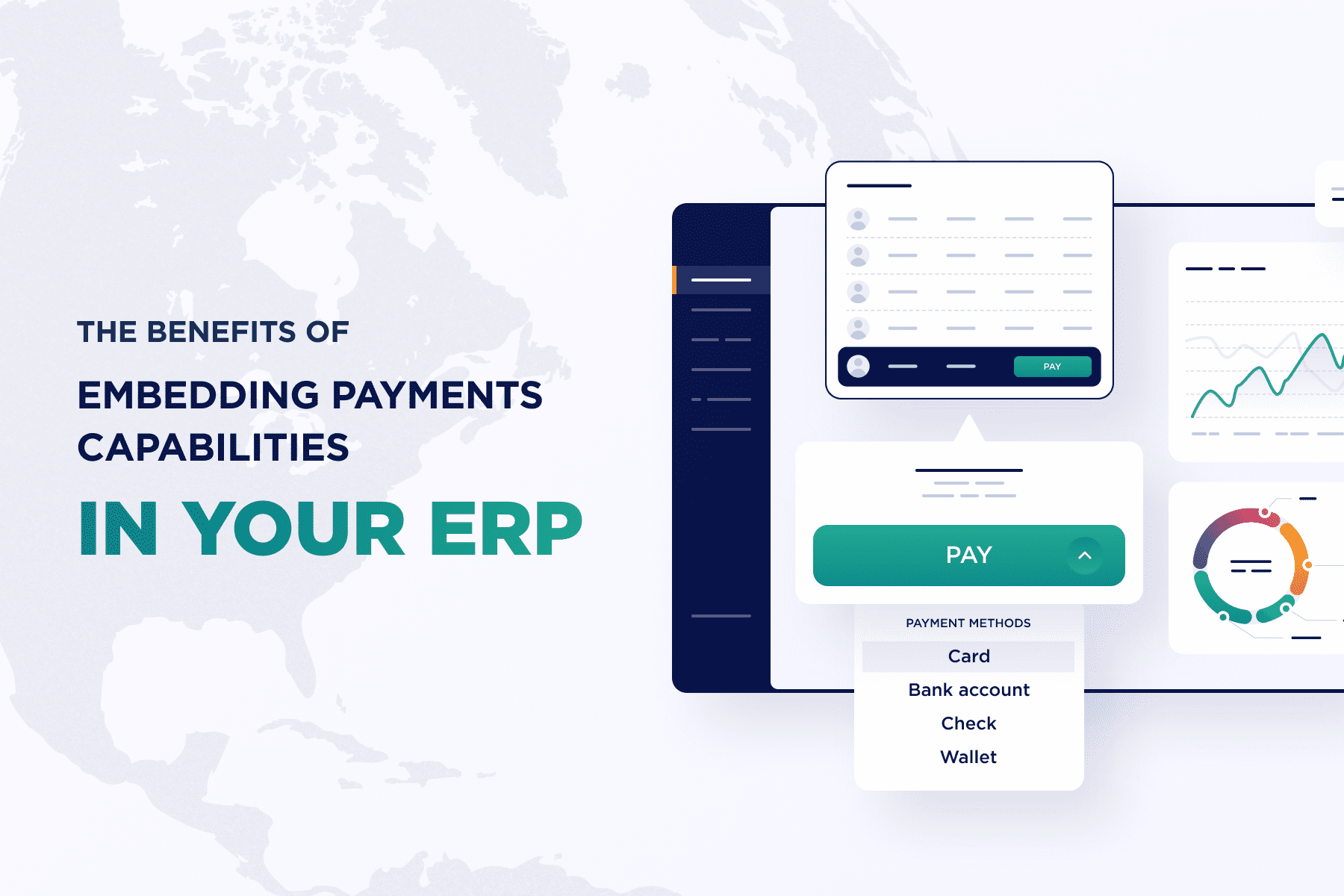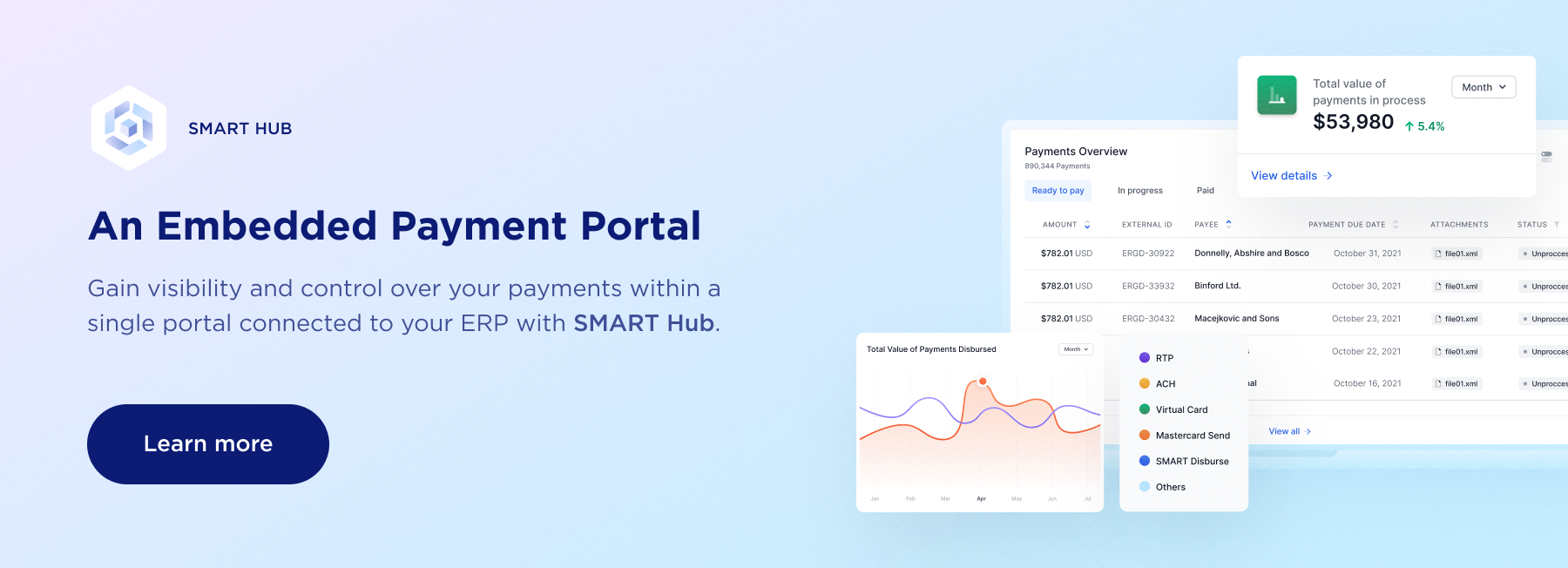The ERP is the financial nerve center of the enterprise.
An ERP collects, processes, manages, and stores data from across the enterprise.
That's why organizations of all sizes are investing heavily in ERPs to manage their core operations.
Yet, many of these organizations are unaware of how much they could extend the value of their ERP investments and streamline the way their organization does business - by embedding multi-rail payments capabilities directly into their ERP.
The Biggest Challenges Facing Payments
Most businesses execute and receive payments through a hodgepodge of line-of-business solutions for accounts payable, accounts receivable, accounting, and more.
While these point solutions may be integrated to some extent with the organization’s ERP, each system comes with its own logins and passwords, account requirements, file formats, and proprietary integrations.
What’s more, many of these point solutions were designed to support a single payment method (such as card), meaning the business must deploy a standalone system or process for any other payment methods that it supports.
Making and receiving payments through this jumble of systems can be a major headache:
Burdensome Disbursements
Making payments is hard for most businesses.
Once an invoice or expense report is approved, staff must print paper checks, attach the corresponding invoice, get the signature of the appropriate person, generate a remittance document, stuff and mail the check and remittance details, and manually reconcile payments as they clear.
Paying suppliers electronically through point solutions isn’t much easier.
Staff must log into multiple systems or bank portals to execute electronic payments, check the payment terms for each supplier, generate and e-mail remittance details, and roll up the various bank statements and spreadsheets for reconciliation. Global payments bring another level of complexity.
 Effortless Disbursements
Effortless Disbursements
By leveraging the data that resides in an ERP, embedded payments solutions make it possible to disburse funds instantly or at a scheduled time (such as a supplier’s payment terms) to a single individual or lots of suppliers, with a few clicks.
Staff can use intuitive screens within the familiar interface of their organization’s ERP.
Limited Payment Options
Point solutions weren’t built for payment processing. They were built for procuring goods and services or processing invoices or applying cash. That’s why most of them offer limited options for making and receiving payments.
The problem is that customers want to pay and get paid in their preferred format, and they are willing to hold up your cash flow or take their business elsewhere if they don’t get the experience they expect.
 Support for Any Payment Type
Support for Any Payment Type
Embedding a payments solution with multi-rail capabilities into your ERP makes it easy to make and receive payments in virtually any format.
You: Automated Clearing House (ACH)?
Us: Of course.
You: Card?
Us: We’ve got you covered.
You: Real-Time Payment (RTP)?
Us: You got it!
You: Zelle?
Us: Sure thing!
What’s more, an embedded payments solution eliminates the hassles of managing standalone payment systems or logging into multiple bank portals.
Slow Cash Conversion Cycle
Getting money in the bank is only part of the equation for receivables departments. They also must match payments with remittances, key remittance details, apply cash against open invoices, and resolve the inevitable exceptions.
All of these manual processes contribute to more customer disputes and write-offs, unapplied cash, delays in clearing credit holds, and unnecessary collections actions on unprocessed receivables.
 Accelerated Cash Flow
Accelerated Cash Flow
Connecting buyers and sellers through a payment solution embedded in their ERPs eliminates friction in the flow of cash. Payments are electronically deposited, and remittance details are uploaded to the biller’s ERP.
This eliminates the need to match payments with remittance documents, key remittance details (or pay a lockbox to do it for you), or spend hours determining how payments should be applied to open invoices.
An embedded payments solution with multi-rail payment capabilities also makes it easy for customers to initiate payments to suppliers; with some payments being settled within moments.
Late Payments
Most suppliers experience late payments from customers, creating cash flow issues. While some late payments can be attributed to customers unwilling or unable to make timely payments, other late payments are the result of confusion about the supplier’s terms.
The root of the problem is that payment terms are typically managed in an organization’s ERP, not in the point solution that it is using to make payments to suppliers.
 Centralized Payment Directory
Centralized Payment Directory
Embedded payments solutions may include a centralized business directory that provides instant access to a supplier’s payment preferences and terms.
Approved invoices can be paid immediately or scheduled for payment. In addition to that, embedded payments solution tracks the status of each payment and reconciles them in real-time.
The Burden of Reconciliation
The more standalone systems that a business uses to make and receive payments, the bigger the reconciliation burden.
Getting to the bottom of things might require a business to log into multiple systems and portals and compare payment data to a bevy of bank account statements or spreadsheets. Discrepancies between the bank statement and the point solution may require days of back-and-forth e-mails and phone calls to sort out.
 Real-Time Reconciliation
Real-Time Reconciliation
When payments are seamlessly integrated into an ERP system, transactions are reconciled in real-time, without the need for human operator intervention.
Every business wants to do more with less. But the more systems you use for making and receiving payments, the bigger the operational and security burden.
It is no wonder that making and receiving payments is so costly, complex, and risky for businesses.
Embedding a payments solution in your ERP offers a better approach than point solutions.
These are the reasons that more and more businesses are eschewing point solutions and making and receiving payments through a multi-rail solution that is embedded within their organization’s ERP.




